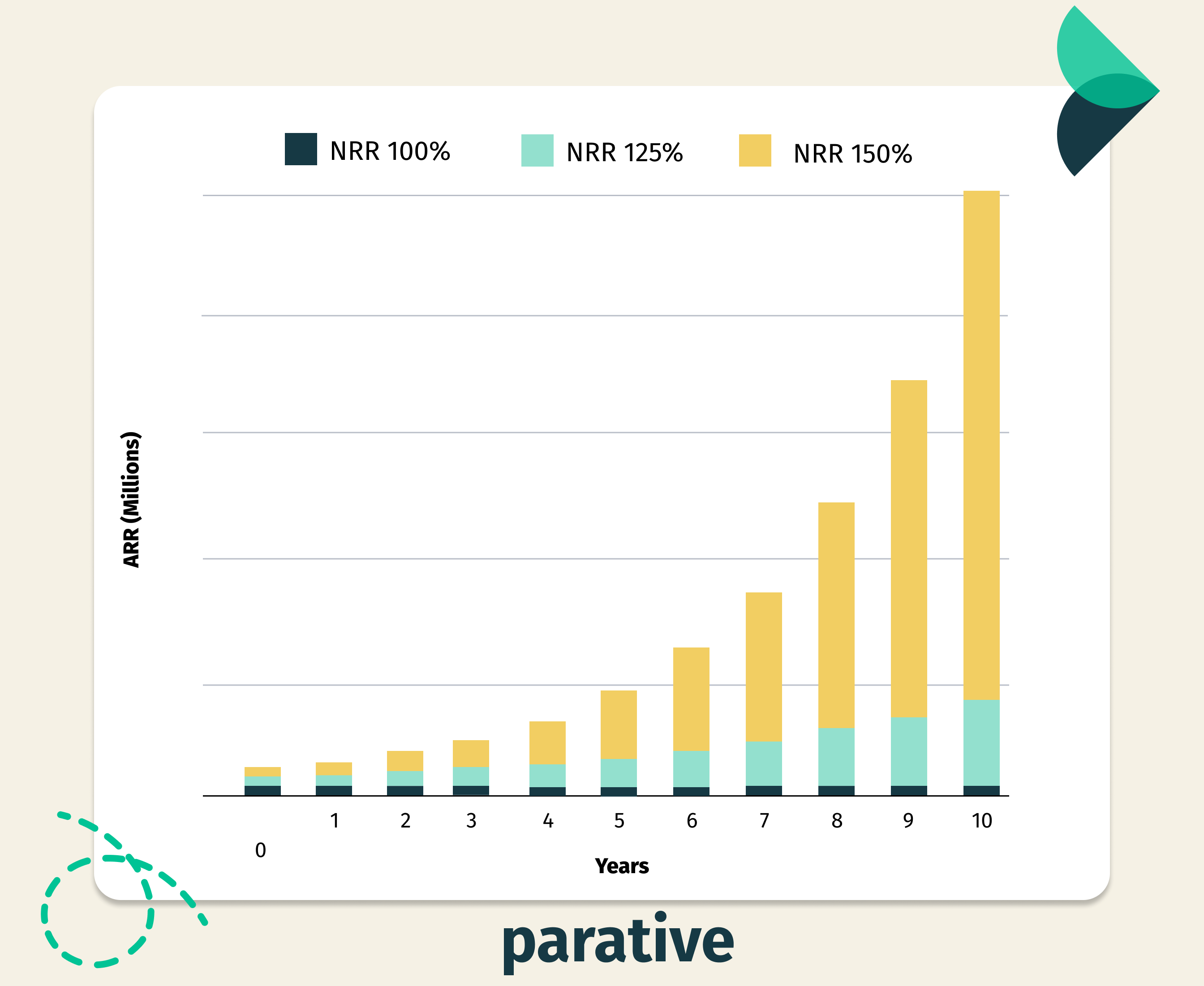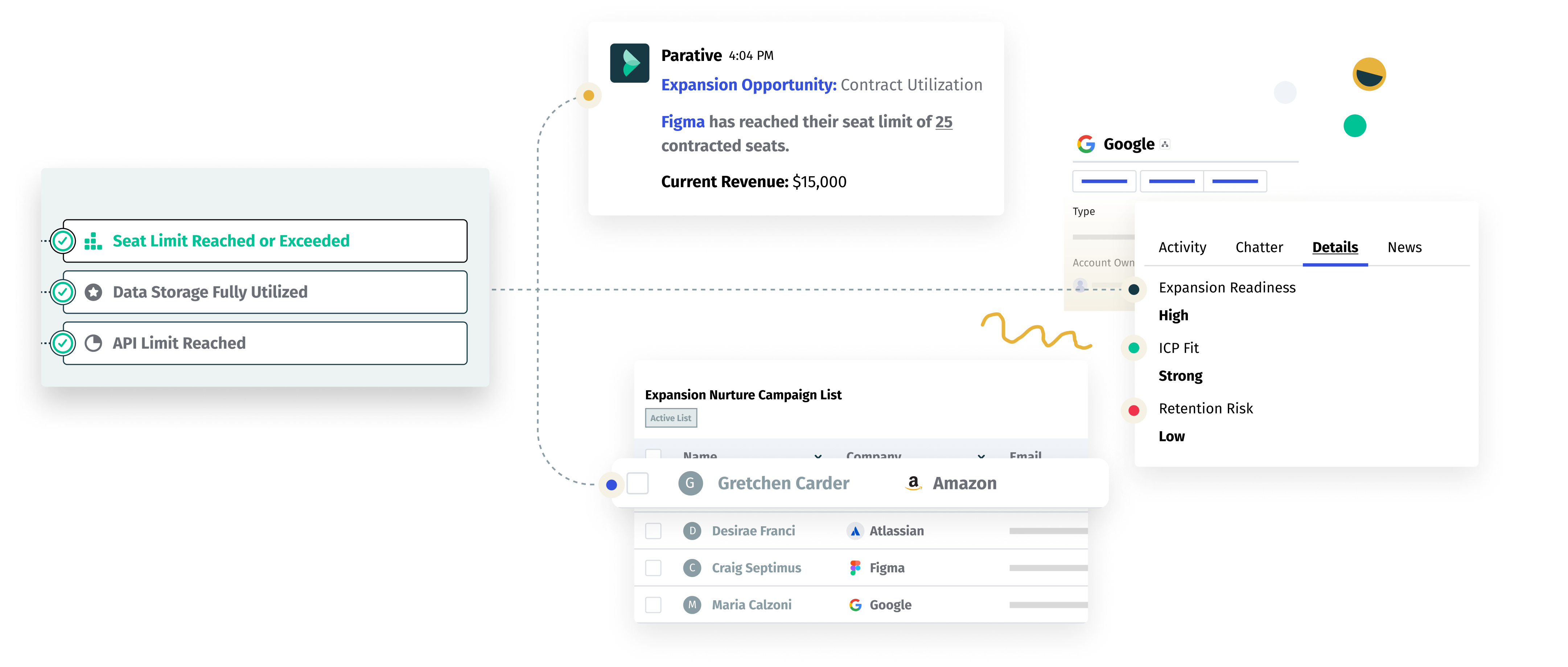 Back to Parative
Back to Parative


As revenue leaders, we're all too familiar with the challenge of expanding our existing customer base and getting more revenue out of existing customer accounts.
But what if I told you that with a few simple strategies in place, you could build a system to identify and capitalize on unspoken signals from your customers that indicate they are ready for expansion?
Expansion opportunities refer to situations in which an existing customer exhibits behaviors or traits that would indicate there is a significant opportunity to expand the lifetime value of the account.
Namely, they are ripe for generating expansion revenue.

This could include hitting the maximum allotment of user licenses for the account, hitting a gated feature in the product, or having a profile match a best-fit profile for an enterprise customer.
The benefits of capturing these expansion opportunities are clear – increased MRR (Monthly Recurring Revenue) and ARR (Annual Recurring Revenue).
But as we prepare for what 2023 has in store, it will be more important than ever to have a system in place that allows us to track and capitalize on these opportunities quickly.
Net Revenue Retention will be key – how well are we managing our customer success teams and equipping them with the right tools to take advantage of expansion opportunities?
In this post, I’ll discuss ways, as a revenue leader, you can capitalize on expansion revenue opportunities.
We'll look at real-life examples and explore how customer success teams can leverage data to identify potential expansions that can help increase MRR and ARR.
By the end of this post, you’ll have a playbook for identifying and capitalizing on expansion opportunities.
So let's get started.
Expansion opportunities can provide a powerful source of revenue for SaaS companies. However, identifying expansion opportunities requires a comprehensive understanding of customer usage, behavior, and firmographic signals.
With the proper systems in place, tracking these signals and uncovering potential expansion opportunities within existing customers or accounts is possible.

Common indicators of expansion opportunity include customers reaching their seat limits, expressing interest in higher-tier features, or needing additional services.
For example, when an account reaches its maximum allotment of user licenses for the account or attempts to access a feature that is only available to enterprise accounts, this may indicate an opportunity to expand the lifetime value of that account.
Additionally, it might be worth exploring further when an account's profile matches a best-fit buyer persona.
To ensure you don't miss any potential expansion opportunities, it's important to have systems that can track customer data and monitor usage patterns.
Parative's Revenue Scoring engine was designed with this purpose in mind:
It identifies key revenue signals by monitoring customer behavior, usage intent, contract consumption, customer feedback, and market conditions; scores each customer's outcome readiness by evaluating them across key revenue signals; automates actions in other tools by proactively alerting teams and triggering workflows; and unifies records and segments customers based on gathered data across systems to identify expansion opportunities.
By leveraging tools like Parative and keeping track of customer data internally, Revenue Leaders can more easily identify potential expansion opportunities that could significantly increase recurring revenue streams over time.
These opportunities should be discussed with both the customer success and management teams to ensure that everyone is aligned on how best to capitalize on them.
By taking advantage of these insights into customer usage patterns and behaviors, businesses can unlock tremendous growth potential, leading to increased revenue from existing customers.

Expansion revenue is a critical part of any successful revenue leader's strategy. Having a clear strategy for capitalizing on expansion opportunities can lead to increased customer lifetime value, higher customer satisfaction, and loyalty, and improved bottom-line results.
Developing an effective expansion revenue strategy involves identifying the customer's needs and researching the market and competitors. It also requires understanding how to best leverage upsells or cross-sells to increase revenue from existing customers.
To help you create an effective expansion strategy, let's take a look at some of the components that make up a successful strategy:
Before launching any expansion efforts, it's important to identify your customer's needs. This can be done through surveys, interviews with key stakeholders, and analysis of customer data. Once you have identified their needs, you can use this information to craft an effective growth strategy tailored specifically to them.
Conduct research on your market and competitors to understand what is happening in the industry. Analyze competitor pricing models, feature sets, and product roadmaps to stay ahead of the competition. Additionally, analyze current customer trends to target better potential customers who may be looking for your product or service.
Identify the best approach for upselling or cross-selling services or products to increase revenue from existing customers. Consider creating customized packages that meet specific customer needs or providing additional services that complement existing offerings. By targeting customers already familiar with your company’s existing products or services, you’ll have an easier time expanding their usage and building more successful relationships with them over time.

Finally, it is important to measure success when implementing an expansion revenue strategy by tracking net revenue retention as the north star metric - this will ensure that you are not only pursuing new business but also maintaining and growing your existing accounts as well.
With these tips in mind, you should now be equipped with all the knowledge necessary for developing an effective expansion revenue strategy for your company.
Now that you have developed your revenue expansion strategy, it's time to implement it. It's important to have a clear plan for executing the strategy and to ensure that you have the right team and resources in place to make it successful. Setting measurable goals and tracking progress is also essential for monitoring the success of your efforts.
How exactly do you go about implementing your strategy? Here are some tips:
The first step is identifying potential customers who may be interested in expanding their relationship with your company. Look at existing customers and customer segmentation data, or use predictive analytics tools to help you identify accounts most likely to take advantage of new services or products.
Once you've identified potential customers, create tailored marketing campaigns and special promotions specifically designed to upsell or cross-sell them on new services or products. Make sure they offer a value proposition that makes the customer feel they are getting something out of the deal – such as discounts, additional features, or access to exclusive content – so they can see what's in it for them.
Equip sales reps with the tools they need to succeed, such as scripts and product knowledge training designed to help them explain the benefits of an expanded relationship in terms that will resonate with potential customers. Ensure they understand how average revenue per account (ARPA) can increase when customers expand their services from your company.
Having a Customer Success team dedicated to helping existing clients get more value from an expanded relationship is essential for long-term success and customer satisfaction. They should be empowered with data-driven insights about each customer’s habits and journey to proactively identify areas where additional services would benefit both parties involved.
Finally, track your results over time to determine which tactics are working best and which ones need improvement based on increased average revenue per account (ARPA). This will help you refine your approach over time and maximize ROI on any investments made to implement the strategy effectively.

Parative's Revenue Scoring Engine can play an important role in executing your revenue expansion strategies successfully by providing built-in predictive scoring capabilities along with automations and alerting that let you capitalize on account signals for expansion in tools like Salesforce or Zendesk without having to switch between apps or wait until the manual analysis is complete before taking action.
With Parative, you can quickly act on opportunities while avoiding over-investment in low-value prospects, reducing time spent while creating more value from each customer interaction.
As revenue leaders consider expansion opportunities, they must also be aware of the challenges they will likely face in capitalizing on them.
These challenges may include customer or internal team resistance, competing priorities, or limited budget.
The key to success is building trust and relationships with customers, communicating the expansion's value, and finding cost-effective solutions.
This can be done through proactive customer success management, personalization of services, and innovative pricing and packaging strategies.
Furthermore, it’s important to consider any external factors affecting a customer's willingness to invest in an expanded product or service offering.
When it comes to overcoming challenges associated with expansion opportunities, it is important for revenue leaders to have an open dialogue with customers and internal teams to ensure that everyone is on board with the proposed changes.
Clear communication of the value proposition should be delivered in a way that resonates with all stakeholders involved. Additionally, revenue leaders should be prepared to identify cost-effective solutions that are tailored to each customer situation.
By taking these steps, revenue leaders can capitalize on expansion opportunities while mitigating associated risks.
Product Led Growth (PLG) is an approach to business growth that focuses on user engagement and usage of a product as the primary driver of revenue. PLG is becoming increasingly popular among revenue leaders as they seek to capitalize on expansion opportunities and increase their customer lifetime value (LTV). By taking a more user-centric approach, PLG puts the focus on ensuring users have a positive product experience to drive growth.

To make the most of PLG, it's important for revenue leaders to understand how users interact with their products and what features are most important to them. This means tracking user behavior and usage patterns over time. With analytics tools such as Google Analytics, product managers can identify which features are being used most often, where customers are dropping off in the user flow, and more. They can then use this information to inform product development decisions and marketing strategies.
Product managers can create targeted campaigns based on specific needs or interests by understanding user behavior. For example, if a brand sees that users are consistently using one feature more than another, it may choose to focus its marketing efforts around that feature or create incentives for customers to use it more often. This not only helps increase customer engagement with that particular feature but also helps grow overall revenue by increasing the product's perceived value.
The insights gained from tracking user behavior should also be used to inform product development decisions. Product managers can identify which features are used most often or areas where customers may struggle when interacting with the product. This information can then be used to prioritize certain features or make changes to improve usability and ensure an optimal customer experience with your product or service.
Overall, product-led growth is key for capitalizing on expansion opportunities and increasing customer LTVs.
Revenue leaders need to understand how users interact with their products to identify potential expansion opportunities and apply the insights they gain from tracking user behavior to effective marketing strategies and product development decisions.
As you can see, it is vital for revenue leaders to identify and capitalize on expansion opportunities as a way of increasing revenue and long-term growth.
To accomplish this, they must be able to track customer signals that indicate when an account may have an opportunity for expansion and leverage data from multiple sources to create unified records.
In addition, they should take advantage of Parative's Revenue Scoring Engine to predict customer likelihood to buy more or churn by monitoring customer behavior, usage, intent, contract consumption, feedback, and market conditions.
With these strategies and tactics in mind, readers can increase their chances of successfully identifying and capitalizing on expansion opportunities. However, if you find that any of the techniques discussed are beyond your reach at the moment, please don’t hesitate to reach out for help.
Start taking advantage of these strategies today—the sooner you do so, the sooner you can benefit from increased revenue growth.